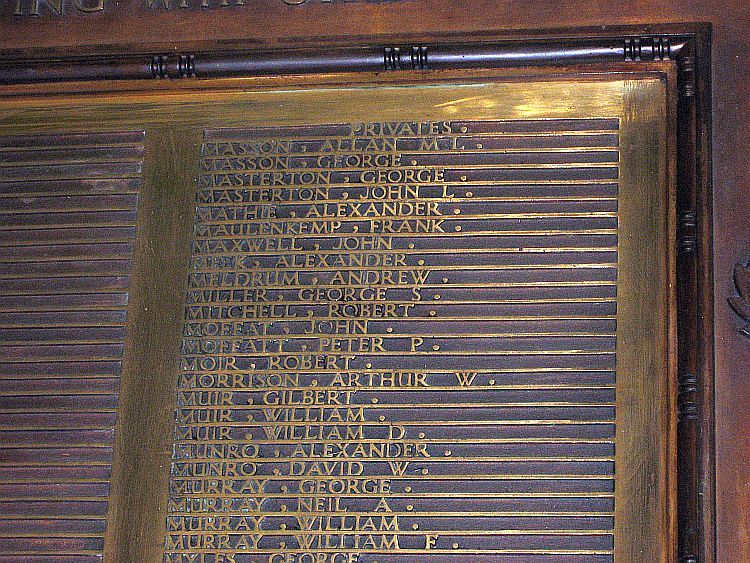Private George Masterton
4271, 15th Highland Light Infantry
died of wounds 25th April 1917
aged 20
St. Sever Cemetery Extension, Rouen, France
Tramway Battalion Memorial, Riverside Museum, Glasgow
Son of George Ellis Masterton and Mary Clark
Forfar, Forfarshire, Scotland
aged 20
St. Sever Cemetery Extension, Rouen, France
Tramway Battalion Memorial, Riverside Museum, Glasgow
Son of George Ellis Masterton and Mary Clark
Forfar, Forfarshire, Scotland
Genealogy
George Masterton was born in Forfar, Forfarshire, Scotland on 28th September 1896, the eldest of a family of four born to George Ellis Masterton, jute factory worker, and Mary Clark who married in 1900 in Forfar. George was with his family there in 1901 and 1911.
Further details of George, his parents and three siblings and the extended family of Mastertons that originally flourished in the Forfar area can be found at the following link.
His War
George Masterton's Medal Index Register show that he served successively in three battalions of the Highland Light Infantry: the 11th, the 12th and the 15th. His Medal Roll Index Card shows that he entered the France and Flanders theatre of war on 3rd August 1915. At that stage, the 15th Battalion was still in Prees Heath camp in Shropshire, so George was either in the 11th or the 12th battalion when he qualified for the 1914-15 Star. But we know that by the time he died of wounds he had been transferred to the 15th Battalion.
The 15th Battalion, Highland Light Infantry, was raised on 2 September 1914 in Glasgow, formed in record time with mostly volunteers from Glasgow Corporation Tramways Department. It was trained initially at Gailes, Ayrshire and in May 1915 moved to Prees Heath, Shropshire under command of 97th Brigade, 32nd Division. It landed in Boulogne on 23 November 1915. In January 1916 it was transferred to 14th Brigade in the same Division.
George was reported wounded on 19th October 1916. In early October, the battalion was in the front line Cambrin Section, Left Sub-Section, in the Pas de Calais and later billeted in Beuvry. On 2nd October, the Unit War Diary records an exchange of Trench Mortar fire, the enemy retaliating between 9pm and 10pm causing one casualty.
George died of wounds on 25th April 1917 (unknown for certain whether from the same wounds suffered in October 1916, or, much more likely, if he recovered and was wounded for a second time. If the October 1916 wound had been a lingering problem, he would have been shipped back to the UK rather than take up space in a field hospital.) On 2nd April, the battalion took part in an offensive in the Bois de Savy suffering 40 casualties, then later in the same month twenty casualties were incurred on 19th April while evacuating Cepy Farm, near Fayet, St Quentin taken only a week earlier as the British Army pursued the Germans in their retreat to the Hindenburg Line. It seems more likely that this is the engagement where George was fatally wounded.
George is buried in St. Sever Cemetery Extension, Rouen, the resting place for those who died in the camp hospitals clustered on the southern outskirts of Rouen.
He is also recorded on the Glasgow Tramways Battalion memorial, now displayed in the Riverside Museum, Glasgow.


The Scotsman
WOUNDED. HIGHLAND LIGHT INFANTRY:- ...Masterton, 4271, G. (Forfar);..
The Scotsman
Edinburgh
19 October 1916
Unit War Diary: 15th Battalion Highland Light Infantry
18th April 1917: Bn in the line. Enemy artillery active. Heavy shelling at CEPY FARM & BOLS DES ROSES. Our artillery shelled St QUENTIN & roads leading North from it. Weather fine.
19th April 1917: Bn in line. At 8PM we evacuated CEPY FARM on instructions from Brigadier. 2/Lieut Nicolson was killed. There were about 20 other casualties. Enemy artillery very active all day. Snipers were also active. Weather fine.
National Archives
Kew, London
Unit War Diaries: WO 95/2393/3
32 Division; 14 Infantry Brigade; 15 Battalion Highland Light Infantry
September 1916 - June 1917
Other Sources
- George Masterton Medal Roll Index Card
- George Masterton Medal Roll-Victory and British War Medal
- George Masterton Medal Roll-1914-15 Star
- George Masterton's Deceased Soldier's Effects
- Battalion War Diary, 15th Battalion, Highland Light Infantry:
- Commonwealth War Graves Commission
- Scottish National War Memorial
- George Masterton in IWM Lives of First World War
- Medals: Victory, British War, 1914-15 Star